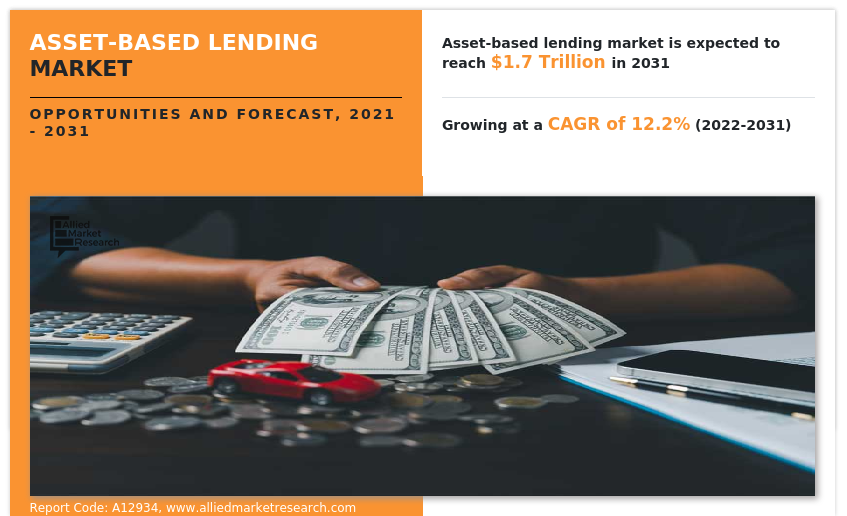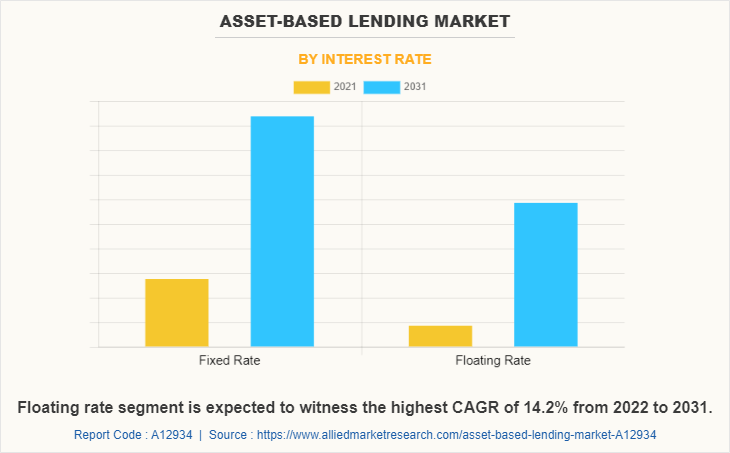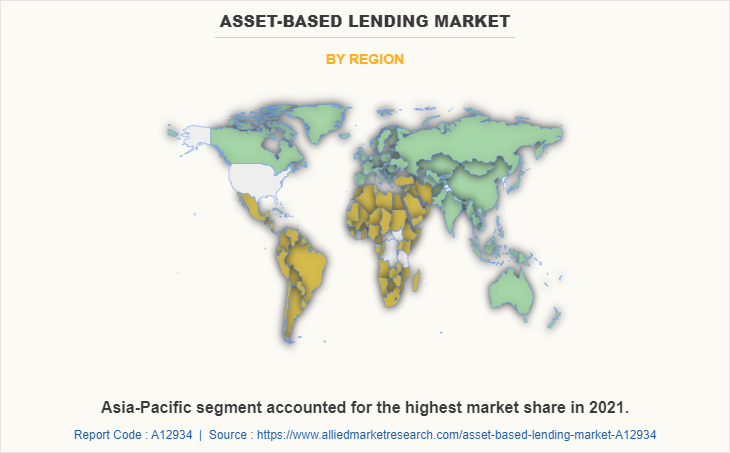Asset-Based Lending Market Research, 2031
The global asset-based lending market was valued at $561.5 billion in 2021, and is projected to reach $1,721.38 billion by 2031, growing at a CAGR of 12.2% from 2022 to 2031.
A loan that is backed by an asset is referred to as asset-based lending. In other words, in asset-based lending, a borrower's asset is used as collateral for the loan that the lender has approved. In asset-based lending, the borrower's assets serve as collateral for the loan. Accounts receivable, inventory, marketable securities, and property, plant, and equipment are a few examples of assets that can be used to secure a loan.

Asset-based lending is less risky than unsecured lending (a loan that is not secured by an asset or assets) since the loan is secured by an asset, and as a result, a lower interest rate is paid. In addition, the more liquid the asset, the less risky the loan is considered and the lower the interest rate demanded. Further, asset-based loans are easier and quicker to obtain than unsecured loans and lines of credit. Thus, these factors notably contribute towards the asset-based lending market growth.
However, higher interest rates than conventional bank loans have and the risk of losing the collateral if borrower default on the loan is the major factor hindering the growth of the market. On the contrary, there is growing usage of advanced technologies in asset-based lending market is expected to boost the market in the coming years. Furthermore, the growing reliance on digital banking is expected to provide lucrative opportunities for the market to grow in upcoming years.
The report focuses on growth prospects, restraints, and trends of the asset-based lending market outlook. The study provides Porter’s five forces analysis to understand the impact of various factors, such as bargaining power of suppliers, competitive intensity of competitors, threat of new entrants, threat of substitutes, and bargaining power of buyers, on the asset-based lending market forecast.
The asset-based lending market is segmented into Type, Interest Rate and End User.
Segment Review
The asset-based lending market is segmented based on type, interest rate, end user, and region. By type, it is categorized into inventory financing, receivables financing, equipment financing, and others. By interest rate, it is bifurcated into fixed rate and floating rate. Based on end user, it is segmented into large enterprises and small and medium-sized enterprises. By region, it is analysed across North America, Europe, Asia-Pacific, and LAMEA.

By interest rate, the fixed rate segment attained the highest asset-based lending market share in 2021. This is attributed to the fact that a fixed rate loan's principal benefit is that it shields the borrower against unexpected and possibly large increases in monthly payments in the event that interest rates rise. Furthermore, loans with fixed rates are simple to comprehend and don't differ much from lender to lender.

By region, Asia-Pacific attained the highest asset-based lending market size in 2021. This is attributed to the fact that the phenomenal growth of digital banking has led to declining usage of physical bank branches with an increasing threat of digital players capturing a substantial market share. Further, the growing of new age fintech companies have also now started venturing out from the traditional payments and transactions.
The report analyzes the profiles of key players operating in the asset-based lending market such as Lloyds Bank, Barclays Bank PLC, Hilton-Baird, JPMorgan Chase & Co., Berkshire Bank, White Oak Financial, LLC, Wells Fargo, Porter Capital, Capital Funding Solutions Inc., and Crystal Financial. These players have adopted various strategies to increase their market penetration and strengthen their position in the asset-based lending market.
Market Landscape and Trends
A logical progression of the services offered by a receivables financier is asset-based lending, or ABL. The ABL provider will consider all of the client company's assets, including fixed assets like property, raw materials, stock, equipment and machinery, and other assets in addition to funding just the assets that are the most liquid, the debtors. The ABL lender will take into account the whole worth of the collection of assets and develop a financing package based on that value as of the moment (and going forward).
Further, it gives the ABL community the chance to revaluate some of the conventional ways of executing ABL from the perspective of developing technologies. Process optimization is made possible by emerging technology. In general, this can improve user experience, save expenses, and increase compliance. Furthermore, all firms have the perspective that they need to use both current and emerging technology to better their operations. Therefore, these are the major market trends for asset-based lending market.
The pandemic had a positive impact on asset-based lending market owing the increased demand for loans due to lockdowns. Some businesses had changed their revolving credit facilities from secured cash-flow-based to asset-based lines of credit as a result of the financial hardship brought on by the COVID-19 pandemic. These facilities were applicable to businesses in retail, wholesale (such as equipment-rental and food-and-beverage companies), and general distribution, where large quantities of inventory are more typical. Thus, the pandemic had a positive impact on asset-based lending industry.
Top Impacting Factors
Aids in Improving Liquidity
The most significant advantage that asset-based finance offers to a business is increased liquidity. Users can have stable finances and predictable cash flow if used properly. Companies that are expanding quickly, have constrained cash flow, or rely on seasonal income and can use this benefit to stabilize operations. Further, asset-based lending arrangements can be the best source of funding for many firms, especially non-investment grade corporations and organizations in transition that cannot normally be eligible for a cash flow loan.
Furthermore, new attractive product introduction by key players in the market is further boosting the growth of the market. For instance, in April 2022, UK-based mid-sized lender Metro Bank launched a new asset-based lending (ABL) product. The bank offered a credit of $ 2,444,500 (£2m) or more against a wide range of assets such as stock, plants, debtors, machinery, and commercial property. Thus, this factor is propelling the growth of the market.
Easier Qualification Criteria for Asset-based Lending
A bank loan or business line of credit are more difficult to get approved for than asset-based financing programs. The business needs to have a short track record of profitability and reasonable financial controls. In addition to that, the organization need to have assets that can be borrowed against. The accounts receivable are the asset that can be leveraged most easily. Because they can be quickly converted into cash, invoices from reputable commercial clients make excellent collateral. The majority of lenders favor funding invoices with a 70-day payment term. Equipment and inventory are additional collateral that the businesses may use to qualify for ABL program. Thus, the easier qualification criteria for asset-based lending is fueling the growth of the market.
Access to Large Sums of Money
Small business owners often do not have the financial capability to raise funding in the debt or equity markets. This can make starting a business extremely expensive and risky. However, with a asset-based lending, it is possible to cover all business startup expenses with availing mortgage loan. This also makes it significantly less intimidating for business owners without extensive resources to obtain a relatively large amount of funding. In addition, by consolidating all financing on one loan, asset-based lending helps to access large sum of money for small businesses. Therefore, this is a major driving factor for the asset-based lending market.
Key Benefits for Stakeholders
- This report provides a quantitative analysis of the market segments, current trends, estimations, and dynamics of the asset-based lending market analysis from 2022 to 2031 to identify the prevailing asset-based lending market opportunity.
- The market research is offered along with information related to key drivers, restraints, and opportunities.
- Porter's five forces analysis highlights the potency of buyers and suppliers to enable stakeholders make profit-oriented business decisions and strengthen their supplier-buyer network.
- In-depth analysis of the asset-based lending market segmentation assists to determine the prevailing market opportunities.
- Major countries in each region are mapped according to their revenue contribution to the global market.
- Market player positioning facilitates benchmarking and provides a clear understanding of the present position of the market players.
- The report includes the analysis of the regional as well as global asset-based lending market trends, key players, market segments, application areas, and market growth strategies.
Asset-Based Lending Market Report Highlights
| Aspects | Details |
| Market Size By 2031 | USD 1.7 trillion |
| Growth Rate | CAGR of 12.2% |
| Forecast period | 2021 - 2031 |
| Report Pages | 345 |
| By Type |
|
| By Interest Rate |
|
| By End User |
|
| By Region |
|
| Key Market Players | Lloyds Bank, Berkshire Bank, Barclays Bank PLC, JPMorgan Chase & Co., Capital Funding Solutions Inc., SLR Credit Solutions, Hilton-Baird Group, White Oak Financial, LLC, Wells Fargo, Porter Capital |
Analyst Review
The market for asset-based lending is witnessing a rise owing to increased demand for automated underwritings, growth in internet of things (IoT) & cloud-based service use, and surge in acceptance of these technologies. In addition, asset-lending and mortgages have undergone a considerable transition similar to other sectors of banking, which is in many aspects reinventing and redefining this vital area for both current and future market participants. Furthermore, automated follow-up calls, automated loan granting, automated document management, and automated reporting are anticipated to boost the growth of the market in upcoming years.
The COVID-19 outbreak had a moderate impact on the asset-based lending market. Moreover, the pandemic led to a huge demand for digital lending services that are provided through channels that do not require any physical touch, including over the phone via the contact center, on mobile devices, or via desktop applications.
The asset-based lending market is fragmented with the presence of key players such as Lloyds Bank, Barclays Bank PLC, Hilton-Baird, JPMorgan Chase & Co., Berkshire Bank, White Oak Financial, LLC, Wells Fargo, Porter Capital, Capital Funding Solutions Inc., and Crystal Financial. Major players operating in this market have witnessed significant adoption of strategies that include business expansion and partnership to reduce supply and demand gap. With increase in awareness & demand for asset-based lending across the globe, major players are collaborating their product portfolio to provide differentiated and innovative products.
The asset-based lending market is estimated to grow at a CAGR of 12.2% from 2022 to 2031.
The asset-based lending market is projected to reach $1,721.38 billion by 2031.
Aids in improving liquidity, Easier qualification criteria for asset-based lending and Access to large sums of money majorly contribute toward the growth of the market.
The key players profiled in the report include reinsurance market analysis includes top companies operating in the market such as Lloyds Bank, Barclays Bank PLC, Hilton-Baird, JPMorgan Chase & Co., Berkshire Bank, White Oak Financial, LLC, Wells Fargo, Porter Capital, Capital Funding Solutions Inc., and Crystal Financial.
The key growth strategies of asset-based lending market players include product portfolio expansion, mergers & acquisitions, agreements, geographical expansion, and collaborations.
Loading Table Of Content...



